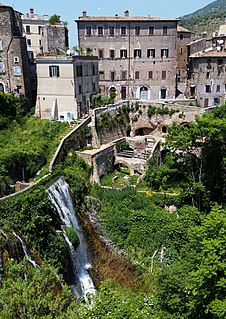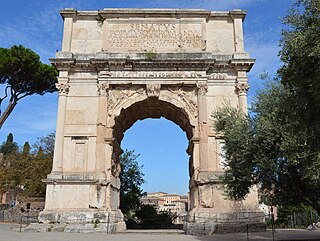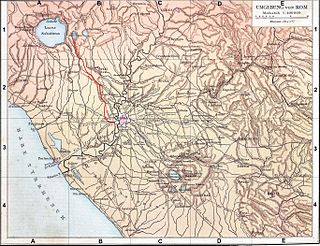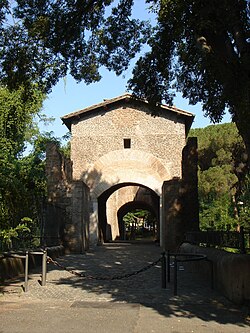
Tivoli is a town and comune in Lazio, central Italy, about 30 kilometres east-north-east of Rome, at the falls of the Aniene river where it issues from the Sabine hills. The city offers a wide view over the Roman Campagna.

The Arch of Titus is a 1st-century AD honorific arch, located on the Via Sacra, Rome, just to the south-east of the Roman Forum. It was constructed in c. 81 AD by the Emperor Domitian shortly after the death of his older brother Titus to commemorate Titus's official deification or consecratio and the victory of Titus together with their father, Vespasian, over the Jewish rebellion in Judaea. The arch contains panels depicting the triumphal procession celebrated in 71 AD after the Roman victory culminating in the fall of Jerusalem, and provides one of the few contemporary depictions of artifacts of Herod's Temple. It became a symbol of the Jewish diaspora, and the menorah depicted on the arch served as the model for the menorah used as the emblem of the state of Israel.

The ancient Romans were the first civilization to build large, permanent bridges. Early Roman bridges used techniques introduced by Etruscan immigrants, but the Romans improved those skills, developing and enhancing methods such as arches and keystones. There were three major types of Roman bridge: wooden, pontoon, and stone. Early Roman bridges were wooden, but by the 2nd century stone was being used. Stone bridges used the arch as their basic structure, and most used concrete, the first use of this material in bridge-building.

The Aniene, formerly known as the Teverone, is a 99-kilometer (62 mi) river in Lazio, Italy. It originates in the Apennines at Trevi nel Lazio and flows westward past Subiaco, Vicovaro, and Tivoli to join the Tiber in northern Rome. It formed the principal valley east of ancient Rome and became an important water source as the city's population expanded. The falls at Tivoli were noted for their beauty. Historic bridges across the river include the Ponte Nomentano, Ponte Mammolo, Ponte Salario, and Ponte di San Francesco, all of which were originally fortified with towers.

The Roman Campagna is a low-lying area surrounding Rome in the Lazio region of central Italy, with an area of approximately 2,100 square kilometres (810 sq mi).

The Pons Fabricius or Ponte dei Quattro Capi, is the oldest Roman bridge in Rome, Italy, still existing in its original state. Built in 62 BC, it spans half of the Tiber River, from the Campus Martius on the east side to Tiber Island in the middle. Quattro Capi refers to the two marble pillars of the two-faced Janus herms on the parapet, which were moved here from the nearby Church of St Gregory in the 14th century.

Ponte Sant'Angelo, originally the Aelian Bridge or Pons Aelius, is a Roman bridge in Rome, Italy, completed in 134 AD by Roman Emperor Hadrian, to span the Tiber from the city centre to his newly constructed mausoleum, now the towering Castel Sant'Angelo. The bridge is faced with travertine marble and spans the Tiber with five arches, three of which are Roman; it was approached by means of a ramp from the river. The bridge is now solely pedestrian and provides a scenic view of Castel Sant'Angelo. It links the rioni of Ponte, and Borgo, to whom the bridge administratively belongs.

The Pons Cestius is an ancient Roman bridge connecting the right bank of the Tiber with the west of the Tiber Island in Rome, Italy. In Late Antiquity, the bridge was replaced and renamed the Pons Gratiani. It is also known as the Italian: Ponte San Bartolomeo, lit. 'Bridge of Saint Bartholomew'. No more than one third of the present stone bridge is of ancient material, as it was entirely rebuilt and extended in the 19th century, after numerous earlier restorations.

Settecamini is the 6th zona of Rome, identified by the initials Z. VI.. Settecamini is also the name of the urban zone 5L, within the Municipio V of Rome.
The Ponte San Lorenzo is a Roman bridge over the river Bacchiglione in Padua, Italy. Constructed between 47 and 30 BC, it is one of the very earliest segmental arched bridges in the world. It is also notable for the slenderness of its piers, unsurpassed in antiquity.

Monte Sacro is the 16th quartiere of the city of Rome in Italy. As a quarter, or second level administrative division, it is one of two that comprise the first level division of Municipio III.

The Porta Nomentana was one of the gates in the Aurelian Walls of Rome, Italy. It is located along viale del Policlinico, around 70 m east of Porta Pia. It is now blocked and merely a boundary wall for the British Embassy.

The Ponte di San Francesco is a medieval segmental arch bridge over the Aniene in Subiaco, Lazio, Italy. Constructed in 1358, its single span measures 37 metres (121 ft).

The Ponte Salario, also called Ponte Salaro during the Middle Ages, is a road bridge in Rome, Italy, whose origins date back to the Roman period. In antiquity, it lay outside the city limits, 3 km north of the Porta Collina, at the point where the Via Salaria crossed the Aniene, a tributary of the Tiber. The visible side arches are assumed to originate from the first stone structure built during the 1st century BC.
The Ponte Altinate is a Roman bridge in Padua, Italy. The late Republican bridge once spanned a branch of the Brenta river whose course is today followed by the street Riviera del Ponti Romani. The structure is located at the crossing with Via Altinate and, lying underground, completely obstructed from view by the modern pavement.

The Ponte Molino is a Roman bridge across the Bacchiglione in Padua, Italy. The span-to-rise ratio of the Late Republican bridge varies between 3.5–4.5 and 1, the ratio of clear span and pier thickness between 4–6.5 and 1.
The Ponte Corvo, rarely Ponte Corbo, is a Roman segmental arch bridge across the Bacchiglione in Padua, Italy. Dating to the 1st or 2nd century AD, its three remaining arches cross a branch of the river and are today partly buried respectively walled up. The span-to-rise ratio of the bridge varies between 2.8 and 3.4 to 1, the ratio of clear span to pier thickness from 4.9 to 6.9 to 1.
Britain's Lost Masterpieces is a factual BBC Four documentary television series that aims to uncover overlooked art treasures in British public collections, in conjunction with Art UK. It is presented by Bendor Grosvenor, along with Emma Dabiri. The series also features the art restoration work of Simon Rollo Gillespie. In North American syndication, the series is called The Art Detectives.

Trieste is the 17th quarter of Rome (Italy), identified by the initials Q. XVII.























